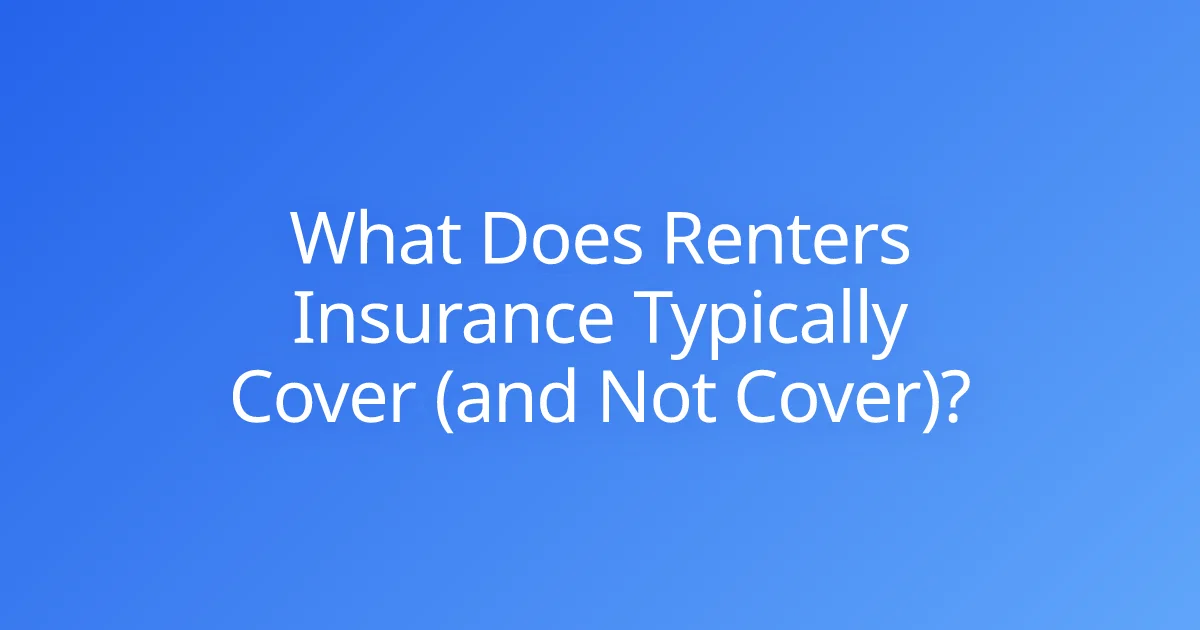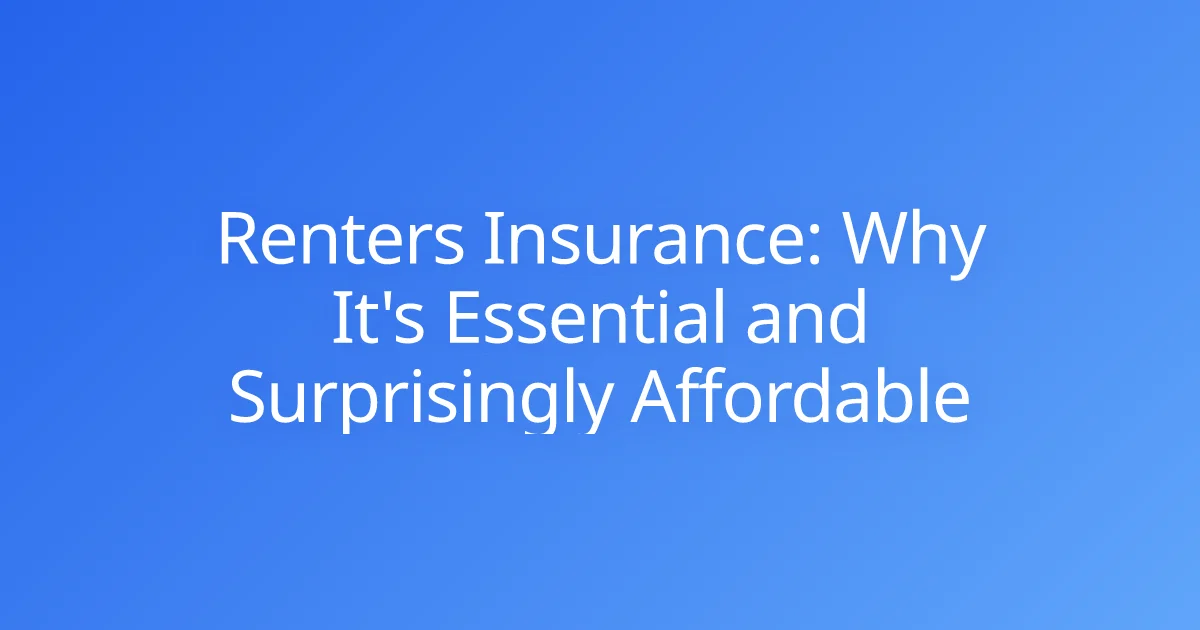What Does Renters Insurance Typically Cover (and Not Cover)?
For many living in rented apartments, condos, or homes, the true scope of their insurance protection remains a mystery. There's a common, yet dangerous, assumption that the landlord's insurance policy offers a safety net for everything that could go wrong. This simply isn't true. While your landlord's policy protects the building structure, it provides absolutely no coverage for your personal belongings or for your liability if someone is injured in your rented space. This leaves a significant gap in financial protection for countless tenants.
At The Policy Explainer, we are dedicated to clarifying these critical distinctions. This comprehensive guide will meticulously break down what renters insurance typically covers, shedding light on the essential protections it provides for your personal property, liability, and living expenses. More importantly, we will also illuminate what renters insurance typically does not cover, outlining common exclusions that are vital for you to understand. By the end, you'll have a clear, expert-level understanding of your renters insurance coverage, empowering you to secure peace of mind and safeguard your financial well-being.
The Foundational Pillars of Renters Insurance Coverage
A standard renters insurance policy, often referred to as an HO-4 policy, is a package of distinct coverages designed specifically for tenants. It steps in to protect your financial interests where your landlord's policy leaves off.
1. Personal Property Coverage (Coverage C)
This is the cornerstone of renters insurance for many. It protects your personal belongings from specified perils, whether they are inside your rented dwelling or even when you're away from home.
- What it covers: Furniture, electronics, clothing, jewelry (up to specific limits), appliances you own (e.g., microwave, portable dishwasher), books, sports equipment, and other personal items.
- Perils Covered (Named Perils): Renters insurance typically operates on a "named perils" basis for personal property. This means your belongings are covered only if the damage or loss is caused by one of the specific perils listed in your policy. Common named perils usually include:
- Fire and lightning
- Windstorm and hail
- Explosion
- Smoke
- Vandalism
- Theft (a very frequent reason for renters claims!)
- Falling objects (e.g., a tree limb crashing through the roof)
- Weight of ice, snow, or sleet (causing structural damage that then damages property)
- Accidental discharge or overflow of water/steam (e.g., burst pipes, overflowing appliances)
- Sudden and accidental tearing apart/cracking/burning/bulging of a built-in appliance
- Freezing of plumbing
- Sudden and accidental damage from artificially generated electrical current (power surges)
- Riot or civil commotion
- Damage from vehicles or aircraft
- Coverage Extends Beyond Your Home: A significant advantage is that your personal property coverage often applies worldwide. If your laptop is stolen from your car across town, or your luggage is lost or stolen on a trip abroad, your renters insurance can help cover the loss.
- Actual Cash Value (ACV) vs. Replacement Cost Value (RCV):
- ACV: Pays the depreciated value of your belongings (what they're worth today).
- RCV: Pays the cost to replace your damaged or stolen items with new ones of similar kind and quality, without deduction for depreciation. RCV is highly recommended for better protection, though it may result in a slightly higher premium.
2. Personal Liability Coverage (Coverage E)
This is perhaps the most critical, yet often overlooked, component of renters insurance. It protects your financial assets if you are found legally responsible for bodily injury or property damage to others, whether the incident occurs in your rented home or elsewhere.
- What it covers: Legal defense costs, medical expenses, and potential settlement awards if:
- A guest slips and falls in your apartment and sustains an injury, and you are deemed negligent.
- Your child accidentally breaks a neighbor's expensive window or damages their property.
- Your pet bites someone.
- A fire originates in your unit due to your negligence and damages other units in the building.
- Example: A candle you left unattended causes a small fire, damaging your unit and part of the unit below. Your liability coverage would help pay for the damage to the other unit and any associated injuries.
3. Loss of Use / Additional Living Expenses (ALE) Coverage (Coverage D)
If a covered peril (like a fire, severe storm, or burst pipe) makes your rented dwelling temporarily uninhabitable, this coverage helps pay for the additional costs you incur while you're displaced.
- What it covers: Essential expenses beyond your normal living costs, such as:
- Hotel or temporary rental accommodation
- Restaurant meals (above your typical grocery budget)
- Laundry services
- Pet boarding fees
- Example: A burst water pipe forces you to move out of your apartment for two weeks while repairs are made. ALE coverage would help cover your hotel bill and additional food expenses during that time.
4. Medical Payments Coverage (Coverage F)
This coverage provides for minor medical expenses for guests who are accidentally injured on your property, regardless of who was at fault. It's often designed to quickly resolve minor injuries without escalating into larger liability claims.
- What it covers: Medical bills for non-residents (e.g., a friend, neighbor, or delivery person) who suffer small injuries in your rented space.
- Example: A friend trips over your rug and sprains their ankle, requiring an urgent care visit. This coverage could help cover their medical care without a formal liability claim.
What Renters Insurance Policies Typically Do Not Cover (Crucial Exclusions)
Understanding what your renters insurance policy doesn't cover is just as vital as knowing its benefits. These insurance exclusions are standard across most policies and can lead to significant out-of-pocket expenses if you're not aware of them.
1. Flood Damage
This is the most common and often devastating exclusion. Standard renters insurance policies do not cover damage to your personal property caused by floods, which includes rising water from external sources like overflowing rivers, heavy rainfall, or storm surge.
- Solution: If you live in a flood-prone area, you need to purchase a separate flood insurance policy for your belongings, typically through the National Flood Insurance Program (NFIP) or a private insurer.
2. Earthquake Damage
Similar to floods, damage to your personal property from earthquakes, tremors, landslides, and other earth movements is not covered by a standard policy.
- Solution: You'll need to purchase a separate earthquake insurance policy or an endorsement if you live in a seismically active region.
3. Maintenance Issues, Wear & Tear, and Pests
Renters insurance covers sudden, accidental events. It does not cover damage that results from a lack of maintenance, gradual deterioration, or simply the aging of items.
- Examples: Mold (unless caused by a sudden, accidental covered peril like a burst pipe), damage from termites, rodents, or other pests, or furniture that simply wears out over time.
4. Roommate's Property
Your renters insurance policy typically only covers your own personal belongings and your own personal liability. Your roommate's property is not covered by your policy.
- Solution: Each roommate needs to purchase their own individual renters insurance policy to protect their possessions and personal liability.
5. Intentional Acts and Illegal Activities
Damage or injury caused intentionally by you or a resident family member is not covered. Furthermore, any losses resulting from illegal activities are excluded.
6. Business Use of Property
While there might be very limited coverage for some business property, if you run a significant home-based business, your standard renters insurance policy will likely offer insufficient protection for business-related property, equipment, or liability.
- Solution: You would typically need a separate business insurance policy or a specific endorsement added to your renters policy to cover your home-based business assets and liability adequately.
7. Property of Others (Unless Caused by Your Liability)
While your liability coverage would respond if you cause damage to someone else's property, your personal property coverage doesn't cover items belonging to friends or family members that are temporarily in your care, unless explicitly stated or covered under specific circumstances.
Understanding Your Policy Details: Deductibles and Limits
Even with comprehensive understanding of what renters insurance covers, two factors directly impact how much you pay out-of-pocket and how much the insurer pays:
- Deductible: This is the amount you pay out-of-pocket for a claim before your insurance coverage kicks in. For example, if you have a $500 deductible and a covered loss causes $2,000 in personal property damage, you pay the first $500, and your insurer pays the remaining $1,500. Choosing a higher deductible often lowers your monthly premium.
- Coverage Limits: Each component of your policy (Personal Property, Liability, Loss of Use) has a maximum dollar amount the insurer will pay for a covered loss. Additionally, there are often sub-limits for specific high-value items like jewelry, furs, or firearms. If your $10,000 engagement ring is stolen, but your policy has a $2,500 sub-limit for jewelry, you'd only receive $2,500 unless it's specifically scheduled.
Enhancing Your Renters Coverage with Endorsements
To bridge some common gaps or increase protection for specific needs, you can often add endorsements (also called riders or floaters) to your renters policy:
- Scheduled Personal Property (Floater): Highly recommended for high-value items (jewelry, art, rare collectibles) that exceed standard sub-limits. This provides broader, often "all-risk" coverage, typically with no deductible, and requires an appraisal.
- Sewer Backup & Sump Pump Overflow: This common cause of water damage is often excluded from standard policies but can usually be added as an endorsement.
- Identity Theft Protection: Covers expenses incurred from identity theft, such as legal fees, lost wages, and credit monitoring services.
Conclusion
Understanding what renters insurance typically covers (and not covers) is fundamental for any tenant seeking genuine financial security. It's a vital safeguard for your personal belongings, provides crucial liability protection against unforeseen accidents, and ensures you have a place to stay if your unit becomes uninhabitable. While its scope is broad, it's equally important to be aware of common insurance exclusions like flood and earthquake damage, which require separate policies, and to understand that it typically doesn't cover a roommate's property or losses due to neglect.
By grasping these core concepts, you can confidently assess your needs, select appropriate coverage limits, and consider beneficial endorsements to ensure your renters insurance coverage provides the most comprehensive protection for your unique situation. Don't leave your valuables and financial well-being exposed; renters insurance is an essential, surprisingly affordable investment in your peace of mind.
Do you have more questions about specific claims or need help determining the right coverage for your belongings? Share your experiences or queries in the comments below!



